

Youtube. Google Images Downloader. Digital Literacy. Newsmap. FlackCheck.org – A project of Annenberg Classroom. Patterns of Deception - Politics. Welcome to FlackCheck.org’s Detecting Patterns of Deception, the beta version of a new page designed to help viewers spot and debunk slippery moves in politics.
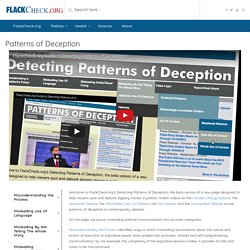
Watch videos on the Climate Change Debate, the Sequester Debate, the Affordable Care Act Debate, the Gun Debate and the Immigration Debate to see patterns of deception in contemporary debates. On the page, we parse misleading political communication into six main categories. Misunderstanding the Process identifies ways in which misleading assumptions about the nature and extent of executive or legislative power drive problematic promises, attacks and self-congratulatory communication. So, for example, the complexity of the legislative process makes it possible for bills and votes to be misconstrued.
Misleading Use Of Language features ways in which politicians exploit the ambiguities and connotations in words to prompt unjustified conclusions. False Logic covers common errors in argument that lead audiences to faulty conclusions. RADAR Framework - Evaluating Sources: Using the RADAR Framework - LibGuides at Loyola Marymount University. Web Evaluation: Does This Website Smell Funny to You? One of my friends spent this past weekend working with her 2nd grade daughter on a research project.

While her daughter flew through the arts and crafts portion and was able to handwrite the “sloppy copy” of her presentation, she struggled when it came to typing the final draft. She didn’t know where the period was. She didn’t know how to use the shift key (and then declared that turning caps lock on and off was far superior and easier than using the shift key).
Typing was taking a lot longer than expected and it was tiring her out. My friend ended up sharing the typing duties with her daughter (who had to dictate from her “sloppy copy”). This reminded me how easy it is to overestimate our students’ abilities when it comes to technology. One of my favorite things to work on with students in this area is website evaluation. 5ws. Online CRAAP Test. Public version of online CRAAP Test - Google フォーム. Whois Lookup, Domain Availability & IP Search - DomainTools. Craig Silverman (craigsilverman) on BuzzFeed. Latest Email Hoaxes - Current Internet Scams - Hoax-Slayer. The definitive Internet reference source for urban legends, folklore, myths, rumors, and misinformation.
Fact-checking U.S. politics. Fact Checker. A Project of the Annenberg Public Policy Center. Building a Culture of Collaboration® In the wake of a contentious U.S. presidential election cycle, researchers and educators are shining a spotlight on critical “information literacy” skills.
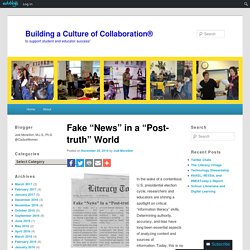
Determining authority, accuracy, and bias have long been essential aspects of analyzing content and sources of information. Today, this is no easy task for students (and adults as well) when authors of “information” do their best to deceive readers or hide their identity behind domains, such as .org, factual-seeming but phony statistical data, and authoritative-sounding language based on “pants of fire” lies. In her 2014 book, It’s Complicated: The Social Lives of Networked Teens, researcher danah boyd wrote, “becoming literate in a networked age requires hard work, regardless of age” (177). While the amount of fake “news” has increased exponentially, the problem of determining authority and validity in information sources has been a critical skill since the early days of the Internet. • Consider the source.
Works Cited. Teaching Information Literacy Now. Last week, a new study from Stanford University revealed that many students are inept at discerning fact from opinion when reading articles online.
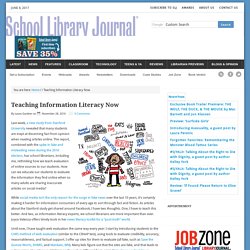
The report, combined with the spike in fake and misleading news during the 2016 election, has school librarians, including me, rethinking how we teach evaluation of online sources to our students. How can we educate our students to evaluate the information they find online when so many adults are sharing inaccurate articles on social media? While social media isn’t the only reason for the surge in fake news over the last 10 years, it’s certainly making it harder for information consumers of every age to sort through fact and fiction.
As articles about the Stanford study get shared around Facebook, I have two thoughts. One, I have to teach this better. In follow-up lessons, we use the CARS strategy to evaluate other websites in order to rank their usefulness. UniversityVideos.org: search, transcripts, and automatic clipping! SchoolJournalism.org : News, Information and Media Literacy. The onset of the digital age forever changed the way readers interact with news and the way that journalists do journalism.
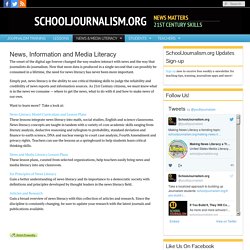
Now that more data is produced in a single second that can possibly be consumed in a lifetime, the need for news literacy has never been more important. An open access resource for faculty and librarians. Photos & Videos. Verification Handbook for Investigative Reporting. Media Literacy Clearinghouse. Center for Media Literacy.
Teaching Resources. HeadlineSpot.com: US Newspapers Online News Headlines, World News, Current Events. Social Media Superstar Finalists Announced! Acknowledging the role social media plays in school library promotion, AASL has launched a new recognition program – Social Media Superstars.
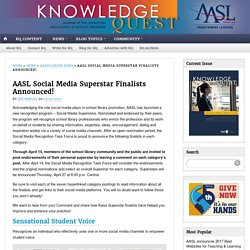
Nominated and endorsed by their peers, the program will recognize school library professionals who enrich the profession and its work on behalf of students by sharing information, expertise, ideas, encouragement, dialog and inspiration widely via a variety of social media channels. After an open nomination period, the Social Media Recognition Task Force is proud to announce the following finalists in each category. Through April 14, members of the school library community and the public are invited to post endorsements of their personal superstar by leaving a comment on each category’s post. After April 14, the Social Media Recognition Task Force will consider the endorsements and the original nominations and select an overall Superstar for each category.
Superstars will be announced Thursday, April 27 at 6:00 p.m. Log In. Listening Activities. Fake-news search engine tracks spread of lies - CNET. Now you can map the web of lies.
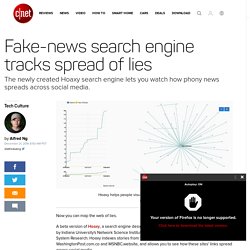
A beta version of Hoaxy, a search engine designed to track fake news, was released Wednesday by Indiana University's Network Science Institute and its Center for Complex Networks and System Research. Hoaxy indexes stories from 132 sites known to produce fake news, such as WashingtonPost.com.co and MSNBC.website, and allows you to see how these sites' links spread across social media.
Fake news has plagued the internet and social networks for a long time but has grown in prominence in the past year or so, forcing Facebook to introduce new features to flag false articles. The hoaxes have lead to real-life consequences, with a fake news creator taking some credit for Donald Trump's White House win and a Washington DC shooting earlier this month related to "Pizzagate.
" Even Pope Francis has chimed in, comparing the spread of fake news to a literal shit show. Type any subject, and Hoaxy responds with a list of fake articles related to the search term. Center for News Literacy – Bringing crucial critical thinking skills for the 21st century to teachers and students. False, Misleading, Clickbait-y, and Satirical “News” Sources.
Log In - New York Times. Log In - New York Times. Framework for Information Literacy for Higher Education. Filed by the ACRL Board on February 2, 2015.

Adopted by the ACRL Board, January 11, 2016. This work is licensed under a Creative Commons Attribution-NonCommercial-ShareAlike 4.0 International License. PDF Version Print copies may be purchased from the Association of College and Research Libraries for $15.00 for a package of 10, including standard postage.
Expedited shipping is available for an additional charge. Fact-checking U.S. politics. Latest Email Hoaxes - Current Internet Scams - Hoax-Slayer. The definitive Internet reference source for urban legends, folklore, myths, rumors, and misinformation. FactCheck.org - A Project of The Annenberg Public Policy Center. 10 Twitter how-tos for Twitter’s 10th birthday – Poynter. In honor of 10 years of journalists tweeting (and getting into Twitter fights, tweetstorming and tweeting hot takes), here are 10 guides to using the social network from our archives.

These include advice from people such as Craig Silverman, now editor at BuzzFeed Canada, on posting Twitter corrections, Nisha Chittal, manager of social media at MSNBC, on figuring out what's public and private on Twitter, and David Beard, executive editor at PRI, who suggested eight ways to attract followers. 10 ways journalists can use Twitter before, during and after reporting a story By Mallary Jean Tenore, 2011 One way Tenore suggests using Twitter is to curate reactions to the news. She writes about tweeting a stylebook change from the Associated Press and watching people on Twitter go crazy.
Newspapers: Fact Sheet. Last updated June 2016 For newspapers, 2015 might as well have been a recession year.
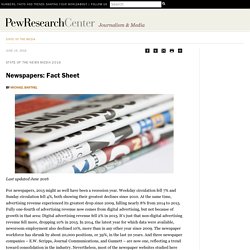
Weekday circulation fell 7% and Sunday circulation fell 4%, both showing their greatest declines since 2010. At the same time, advertising revenue experienced its greatest drop since 2009, falling nearly 8% from 2014 to 2015. Fully one-fourth of advertising revenue now comes from digital advertising, but not because of growth in that area: Digital advertising revenue fell 2% in 2015. It’s just that non-digital advertising revenue fell more, dropping 10% in 2015. Word of the Year 2016 - Oxford Dictionaries. Comment choisir vos informations - Damon Brown. News Use Across Social Media Platforms 2016. A majority of U.S. adults – 62% – get news on social media, and 18% do so often, according to a new survey by Pew Research Center, conducted in association with the John S. and James L. Knight Foundation. In 2012, based on a slightly different question, 49% of U.S. adults reported seeing news on social media.
But which social media sites have the largest portion of users getting news there? AllSides. Stony Brook Center for News Literacy. On student scrutiny: two strategies. We’re focusing a lot of attention these days of helping students determine credibility. For many of us, this is not a hot new topic. I dug around a bit and dusted off a couple of tools that, I think, stand the test of time.
You are welcome to make copies and retool them for you own needs. This Current Events Analysis Scaffold forces thinking beyond the Ws. And then there’s my magic bullet. Evaluative, annotated works cited sections require and inspire the development of critical research and evaluation skills. Teaching about Fake News. Teaching about Fake News. Hobbs%20What%20Society%20Needs%20PDF 0.
Mind Over Media: Analyzing Contemporary Propaganda. News literacy vs. media literacy - Columbia Journalism Review. Three years ago, pioneer media literacy scholar Renee Hobbs published a short critique of what she viewed as troubling trends emerging in news literacy education. She argued on the site Nieman Reports against teaching news literacy in a way that romanticizes the industry or merely transforms a Journalism 101 class into a news literacy one, teaching students the fundamentals and ideals of the craft.
In the comments, there is a lengthy rebuttal from Dean Miller, director of Stony Brook’s Center for News Literacy. “Dr. Hobbs’ critique of News Literacy would be devastating if it described the way News Literacy courses are actually taught,” he wrote. “But, what a perfect lesson in the need for News Literacy,” he continued. The exchange represents the existence of ongoing factions in the news literacy world, which have become starker as access to news literacy training grows. Media Literacy Research, Resources, Lessons and Project Ideas.
Five Key Questions Form Foundation for Media Inquiry. EdWebet 75 - Digital Literacy (Part II) - Google Slides. The Intersection of Digital and Media Literacy. Because both digital and media literacy are fairly new concepts, there is considerable debate amongst experts and academics around the world as to how they should be defined. It is generally agreed that skills and competencies for digital literacy and media literacy are closely related to each other and to additional “21st-century” skills that are needed for living and working in media- and information-rich societies. [i] For example, the key concepts for media literacy – that media is constructed; that audiences negotiate meaning; that media have commercial, social and political implications; and that each medium has a unique aesthetic form that affects how content is presented – are as equally applicable to watching TV news as to searching for health information online.
Digital literacy encompasses the personal, technological, and intellectual skills that are needed to live in a digital world. EdWeb.net - Cookies Required. USA Today: Students need to know this for media literacy. Students today are increasingly turning to online new sources to meet their research needs. Reading Like A Historian. The Reading Like a Historian curriculum engages students in historical inquiry. Author craft and "About Us" Nine Elements.
Nine Themes of Digital Citizenship Digital citizenship can be defined as the norms of appropriate, responsible behavior with regard to technology use. Information Industry News + New Web Sites and Tools From Gary Price and Shirl Kennedy. The News Literacy Project. Media Literacy Clearinghouse. Media Literacy Toolkit – Newsela. Five Key Questions Form Foundation for Media Inquiry. Hearing from a Fake News Creator. And The Word 'Liar': Intent Is Key. President Trump spoke at CIA headquarters in Langley, Va., on Jan. 21. He blamed the media for reports that he is feuding with the intelligence services, after comparing them to Nazi Germany. Olivier Doulier/Pool/Getty Images hide caption toggle caption Olivier Doulier/Pool/Getty Images President Trump spoke at CIA headquarters in Langley, Va., on Jan. 21. Breitbart News Network. And The Word 'Liar': Intent Is Key.
Listenwise - Hearing from a Fake News Creator. Best News Sources for Kids. Mozilla Learning. Fact-checking U.S. politics. Don't Get Faked by the News. Fake News: A Library Resource Round-Up. Renee Hobbs @ UN. Don't Get Faked by the News. Allsides: Curating diverse perspectives (or looking at news from most sides now) What Essential Web Literacy Skills are Missing from Current Learning Standards? News Literacy Learning Experiences.